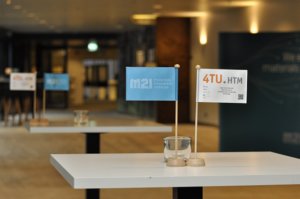Metamaterials
Meeting Materials 2021, the annual M2i conference, was organized in close collaboration with 4TU.HTM.
Aim
The aim of this session is to bring together scientists with interest and expertise on metamaterials, for an exchange of ideas and observations both with each other and with the audience attending the Meeting Materials conference. The audience will involve university researchers, researchers from research institutes, and (R&D) representatives of companies, both large multi-national corporates as well as SMEs from a broad range of materials industries.
Speakers
- Dr.ir. Varvara Kouznetsova
Title: Metamaterials: emergent technology for a new design paradigm
Associate Professor, Department of Mechanical Engineering, Mechanics of Materials, Eindhoven University of Technology
Presentation
The presentation by Varvara Kouznetsova is available as a Pdf file.
(Unfortunately, the movies in the presentation cannot be shown in the Pdf file.)
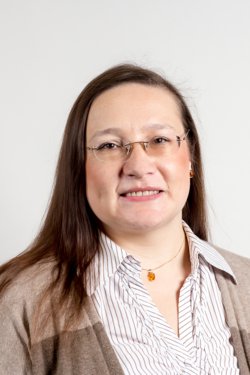 Abstract
Abstract
Metamaterials are architected materials with an internal structure which is rationally designed to achieve unique properties beyond the properties as determined by their constituent materials. While originally introduced for electromagnetic applications, the concept has more recently been extended to the mechanical domain. Mechanical metamaterials allow to create unique values for material properties (e.g. strength over weight, Poisson ratio etc.) and create new functions (e.g. actuation and unusual kinematics, damping and vibration isolation, etc.). The emerging metamaterial properties open new, previously unfeasible design possibilities, thus providing the shift in the current design paradigm. In this talk, a brief overview of the main classes of mechanical metamaterials will be given followed by a few more specific examples of metamaterial applications for control and manipulation of elastic and acoustic waves.
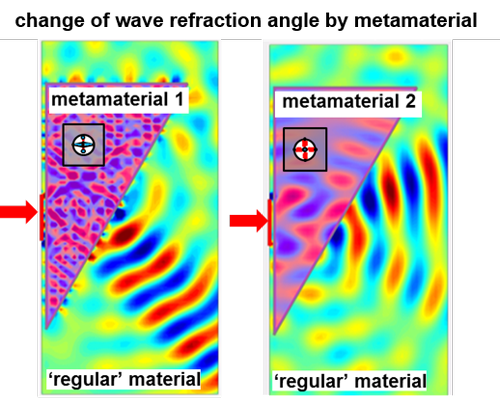
References
- P. B. Silva, T. van Nuland, T. S. van Loon, V. Zega, M. J. Leamy, M. G. D. Geers, and V. G. Kouznetsova, 'Acoustic metamaterials: Metamaterials for wave control and manipulation by exploring nonlinearity'. Innovative Materials, 2018, 4, pp. 30-35
- Liu, L., Sridhar, A., Geers, M. G. D., & Kouznetsova, V. G. (2021). Computational homogenization of locally resonant acoustic metamaterial panels towards enriched continuum beam/shell structures. Computer Methods in Applied Mechanics and Engineering, 387, [114161]. https://doi.org/10.1016/j.cma.2021.114161
- Zega, V., Silva, P. B., Geers, M. G. D., & Kouznetsova, V. G. (2020). Experimental proof of emergent subharmonic attenuation zones in a nonlinear locally resonant metamaterial. Scientific Reports, 10, [12041]. https://doi.org/10.1038/s41598-020-68894-3
- Van Nuland, T., Brandão Silva, P., Sridhar, A., Geers, M., & Kouznetsova, V. (2019). Transient analysis of nonlinear locally resonant metamaterials via computational homogenization. Mathematics and Mechanics of Solids, 24(10), 3136–3155. https://doi.org/10.1177/1081286519833100
- Sridhar, A., Liu, L., Kouznetsova, V. G., & Geers, M. G. D. (2018). Homogenized enriched continuum analysis of acoustic metamaterials with negative stiffness and double negative effects. Journal of the Mechanics and Physics of Solids, 119, 104-117. https://doi.org/10.1016/j.jmps.2018.06.015
- Dr. Alejandro M. Aragón
Title: Advanced computational tools for the analysis and design of metamaterials
Assistant Professor, Faculty of Mechanical, Maritime and Materials Egineering (3mE), Precision and Microsystems Engineering (PME), Delft University of Technology
Presentation
The presentation by Alejandro M. Aragón is available as a Pdf file.
 Abstract
Abstract
The design of metamaterials has relied to a large extent in the trial-and-error empirical approach. This intuition-based experimental approach is not only time-consuming but also expensive, and thus restricts significantly the design process to be used in technological applications. As “metamaterial architects” we need to resort to systematic design procedures, for which computational tools have proven to be effective. "Virtual prototyping," however, relies on efficient and accurate computational models that can faithfully predict the behavior of real prototype. Proper computational design procedures not only need to represent faithfully the underlying physics, but also require efficient methodologies to discretize and solve the corresponding partial differential equations (PDEs), and all within an iterative procedure in pursuit of optimal designs. This presentation focuses on the development of efficient, robust, and scalable computational methodologies for analysis and design that are able to explore the vast geometry-property spectrum in pursuit of optimized metamaterials. Emerging enriched finite element techniques are used for computational analysis and topology optimization of metamaterials, including those for noise attenuation and for tailored fracture behavior.
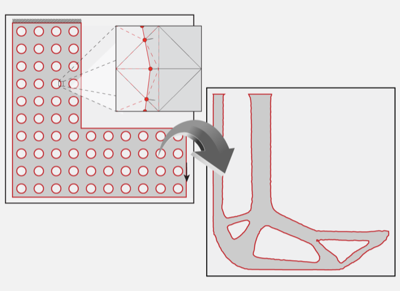
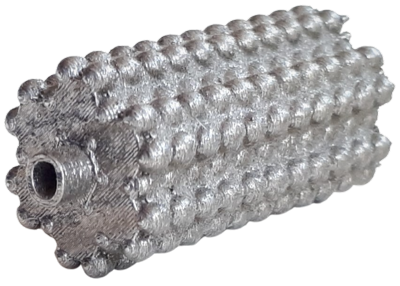
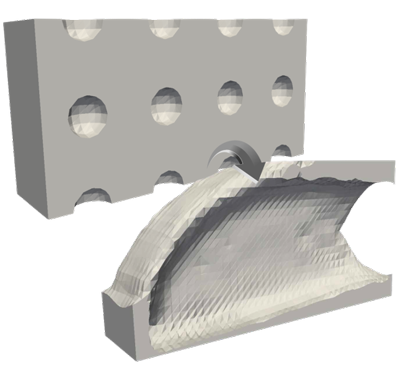
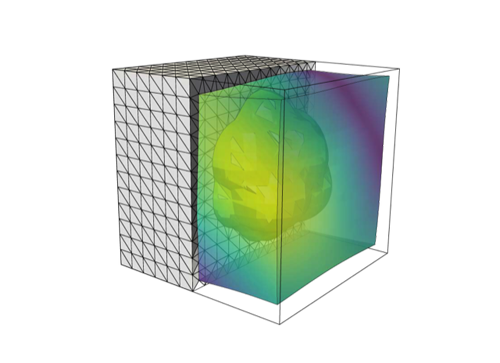
References
- J. Zhang, F. van Keulen, and A. M. Aragón. “On Tailoring Fracture Resistance of Brittle Structures: A Level Set Interface-enriched Topology Optimization Approach”. Comput. Methods in Appl. Mech. Eng. (2021, In Press).
- S. J. van den Boom, F. van Keulen, and A. M. Aragón. “Fully decoupling geometry from discretization in the Bloch-Floquet finite element analysis of phononic crystals”. Comput. Methods in Appl. Mech. Eng. 382 (2021), p. 113848. https://doi.org/10.1016/j.cma.2021.113848
- S. J. van den Boom, J. Zhang, F. van Keulen, and A. M. Aragón. “An interface-enriched generalized finite element method for level set-based topology optimization”. Struct. Multidiscip. O. 63.1 (2021), pp. 1–20. https://doi. org/10.1007/s00158-020-02682-5
- Dr. Corentin Coulais
Title: Dissipative metamaterials
Associate Professor, Faculty of Sience, Van der Waals-Zeeman Institute (WZI), University of Amsterdam
Abstract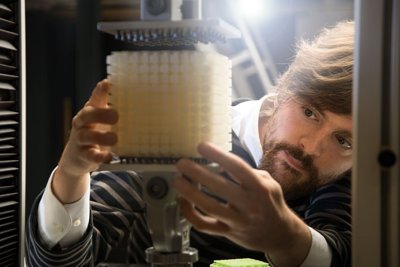 In this talk, I will discuss how the buckling instability can be used as a route to create metamaterials with shape-changing and enhanced energy absorption capabililities.
In this talk, I will discuss how the buckling instability can be used as a route to create metamaterials with shape-changing and enhanced energy absorption capabililities.
References
Oligomodal metamaterials with multifunctional mechanics. Bossart A.*, Dykstra D.M.J.*, van der Laan J. and Coulais C., Proc. Natl. Ac. Sc. U.S.A 118 (21). https://doi.org/10.1073/pnas.2018610118
Viscoelastic snapping metamaterials. Dykstra D.M.J., Busink J., Ennis B. and Coulais C., J. Appl. Mech. [invited article], 86, 111012(2019). https://doi.org/10.1115/1.4044036
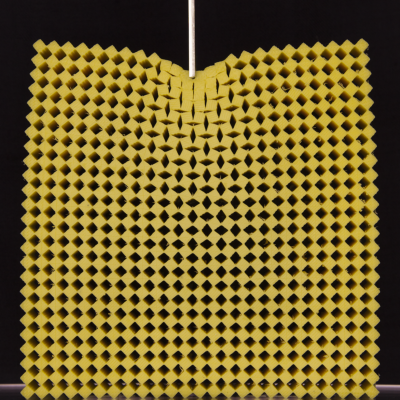
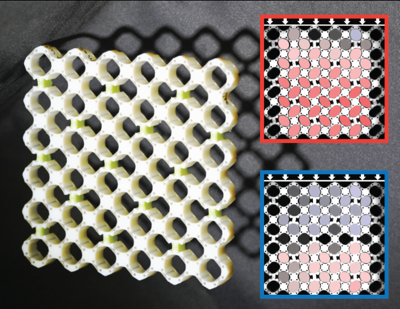

- Prof.dr. Maria Loi
Title: Colloidal quantum dots based metamaterials for optoelectronics
Professor of Photophysics and Optoelectronics, Faculty of Science and Engineering, University of Groningen
Presentation
The presentation by Maria Loi is available as a Pdf file.
Abstract One of the promises of the combination of quantum mechanics and nanotechnology is the ability to design materials with tailor-made physical properties. While there have been several successful examples, as in the case of color and refractive index tuning by the material structure, the development of such metamaterials for opto-electronic applications has been lagging behind. Most current applications of colloidal quantum dots are based on disordered arrays, but already show great prospects for this class of materials. Achieving ordered, macroscopic crystal-like assemblies has been in the focus of researchers for years, since it would allow for easier exploitation of the quantum confinement-based electronic properties with tunable dimensionality. In this work, we show a systematic analysis on the charge transport in PbSe CQD superlattices and its dependence on the nanoscale structure of the samples. We fabricate samples using four different ligands that result in slightly different nanoscale organization of the CQDs, and characterize the electron transport properties of the superlattices in ionic gel-gated field-effect transistors (FETs). A large improvement in the electron mobility up to 24 cm2/Vs is observed upon increasing the width of the interparticle bridges, “necks”. The samples with higher number, but narrower necks show mobilities an order of magnitude lower, suggesting that the neck width is the dominant factor over the number and homogeneity of the connections for efficient charge transport. This is the first evidence of such high mobilities achieved in ordered networks of CQDs and opens the way to further exploitation of these solids in (opto)electronics.
One of the promises of the combination of quantum mechanics and nanotechnology is the ability to design materials with tailor-made physical properties. While there have been several successful examples, as in the case of color and refractive index tuning by the material structure, the development of such metamaterials for opto-electronic applications has been lagging behind. Most current applications of colloidal quantum dots are based on disordered arrays, but already show great prospects for this class of materials. Achieving ordered, macroscopic crystal-like assemblies has been in the focus of researchers for years, since it would allow for easier exploitation of the quantum confinement-based electronic properties with tunable dimensionality. In this work, we show a systematic analysis on the charge transport in PbSe CQD superlattices and its dependence on the nanoscale structure of the samples. We fabricate samples using four different ligands that result in slightly different nanoscale organization of the CQDs, and characterize the electron transport properties of the superlattices in ionic gel-gated field-effect transistors (FETs). A large improvement in the electron mobility up to 24 cm2/Vs is observed upon increasing the width of the interparticle bridges, “necks”. The samples with higher number, but narrower necks show mobilities an order of magnitude lower, suggesting that the neck width is the dominant factor over the number and homogeneity of the connections for efficient charge transport. This is the first evidence of such high mobilities achieved in ordered networks of CQDs and opens the way to further exploitation of these solids in (opto)electronics.
References
- S. Shao, J. Liu, G. Portale, H.-H. Fang, G. R. Blake, G. H. ten Brink, L. J. A. Koster, and M. A. Loi, “Highly Reproducible Sn-Based Hybrid Perovskite Solar Cells with 9% Efficiency” Adv. Energy Mater., 8, 1702019 (2018). https://doi.org/10.1002/aenm.201702019
- H.-H. Fang, S. Adjokatse, S. Shao, J. Even, M. A. Loi, “Long-lived Hot-carrier Light Emission and Large Blue Shift in Formamidinium Tin Triiodide Perovskites” Nature Comm. 9, Article #: 243 (2018). https://doi.org/10.1038/s41467-017-02684-w
- D. M. Balazs, K. I. Bijlsma, H.-H. Fang, D. N. Dirin, M. Döbeli, M. V. Kovalenko, M. A. Loi, “Stoichiometric control of the density of states in PbS colloidal quantum dot solids” Science Advances 3:eaao155 (2017). https://doi.org/10.1126/sciadv.aao1558
- H. –H. Fang, S. Adjokatse, H. Wei, J. Yang, G. R. Blake, J. Huang, J. Even, M. A. Loi, “Ultrahigh Sensitivity of Methylammonium Lead Tribromide Perovskite Single Crystals to Environmental Gases” Science Advances, 2, e1600534 (2016). https://doi.org/10.1126/sciadv.1600534
- H.-H. Fang, F. Wang, S. Adjokatse, N. Zhao, M. A. Loi, “Photoluminescence Enhancement in Formamidinium Lead Iodide Thin Films” Advanced Functional Materials, 26, 4653 (2016). https://doi.org/10.1002/adfm.201600715
- H. Wei, Y. Fang, P. Mulligan, W. Chuirazzi, H. –H. Fang, C. Wang, B. R. Ecker, Y. Gao, M. A. Loi, L. Cao, J. Huang, “Sensitive X-Ray Detectors Made of Methylammonium Lead Tribromide Perovskite Single Crystals” Nature Photonics, 10, 333 (2016). https://doi.org/10.1038/nphoton.2016.41
Maira Loi, Professor of Photophysics & Optoelectronics, has received the Physics Prize 2018. The prize is for excellent physics research by a physicist working in the Netherlands.
Source: University of Groningen
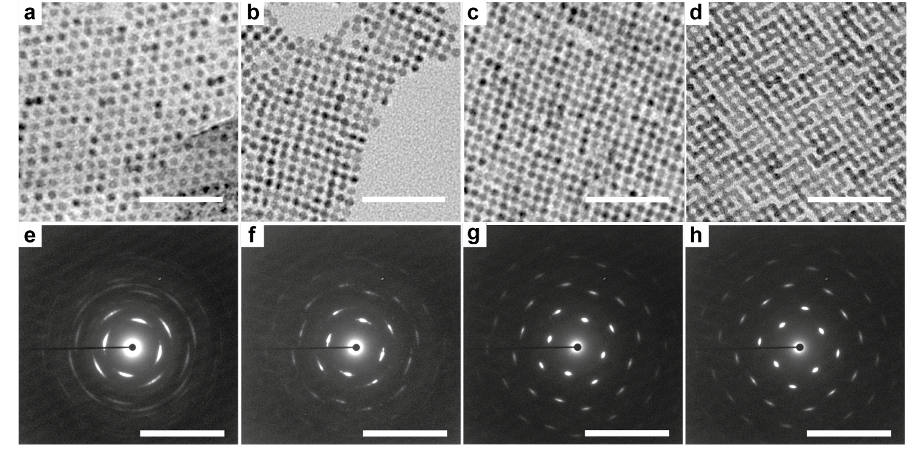
Image: D. M. Balazs et al., Adv. Mater. 2018, 30, 1802265
- Dr. Ondrej Rokos
Title: Design and modelling of active mechanical metamaterials
Assistant Professor, Department of Mechanical Engineering, Mechanics of Materials, Eindhoven University of Technology
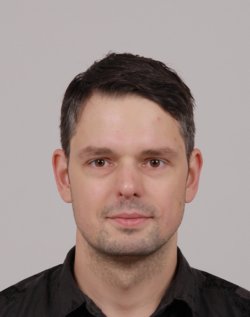 Presentation
Presentation
The presenstion by Ondrej Rokos is available as a Pdf file.
Abstract
Exploration of the metamaterials’ design space has seen in recent years a great advent. However, most of the efforts have focused largely on passive mechanical properties. To leverage full functionality, these (meta-)materials need to be made active, fully exploring their switchable properties and modularity. This type of materials holds promise in numerous engineering applications such as soft-robotics, dynamic vibration control, biomedical devices, or haptics.
This contribution aims to computationally explore possibilities of active metamaterials using magnetic field actuation in combination with synthetic antiferromagnetic nanoplatelets, dispersed in an otherwise homogeneous polymeric base matrix, thus allowing to manipulate matter on the nanoscale level via application of local torques and forces through remotely applied magnetic fields. Such a setting results in magnetically hard and mechanically soft materials. Starting with conventional metamaterial microstructural morphologies such as a square or a hexagonal stacking of circular holes, similar patterns as those observed upon mechanical actuation due to internal buckling are recovered by specifically designing remanent magnetic fields with respect to metamaterial’s geometry. Further options and optimization are explored, focusing on qualitative as well as quantitative change in mechanical properties, including tunable effective stiffness or anisotropy.
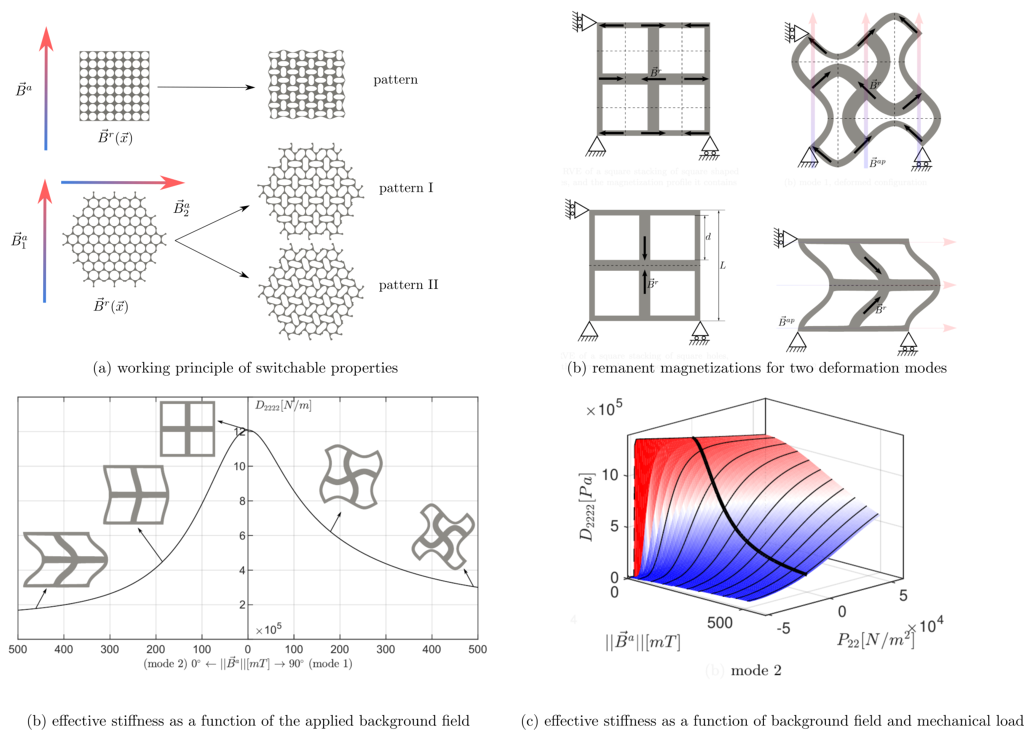
References
B.J.M. Schroeders, O. Rokoš, R.H.J. Peerlings. “Computational design and optimization of magnetoactive metamaterials”. In preparation (2022).
- Dr. Jieun Yang
Title: Acoustic metamaterials and their potential in the built environment
Assistant Professor, Department of the Built Environment, Building acoustics, Eindhoven University of Technology
Presentation
The presentation by Jieun Yang is available as a Pdf file.
Abstract Noise is considered a silent killer that causes severe health issues and negatively impacts our well-being. While the demand for the development of solutions to reduce noise and its harmful effects is increasing, developments in conventional acoustic technologies fall short in adequately addressing noise problems. The advent of acoustic metamaterials, however, is bringing a new approach to combat noise pollution. By using the design methodologies of acoustic metamaterials, it is possible to design materials/structures with an exceptional noise-reducing performance which is unobtainable with conventional methodologies. In this talk, I will introduce some examples of noise-reducing acoustic metamaterials and discuss their potential application in the fields of the built environment.
Noise is considered a silent killer that causes severe health issues and negatively impacts our well-being. While the demand for the development of solutions to reduce noise and its harmful effects is increasing, developments in conventional acoustic technologies fall short in adequately addressing noise problems. The advent of acoustic metamaterials, however, is bringing a new approach to combat noise pollution. By using the design methodologies of acoustic metamaterials, it is possible to design materials/structures with an exceptional noise-reducing performance which is unobtainable with conventional methodologies. In this talk, I will introduce some examples of noise-reducing acoustic metamaterials and discuss their potential application in the fields of the built environment.
References
- J. Yang, M. Hornikx, "Low-frequency noise reduction by a noise barrier made of a resonator array," Euronoise 2021, Online, October 2021.
- J. Yang, J.S. Lee, H.R. Lee, Y.J. Kang and Y.Y. Kim, “Slow-wave metamaterial open panels for efficient reduction of low-frequency sound transmission,” Appl. Phys. Lett., 112(9), 091901, 2018.
- J. Yang, J.S. Lee, and Y.Y. Kim, “Multiple slow waves in metaporous layers for broadband sound absorption,” J. Phys. D: Appl. Phys. 50, 015301, 2017.
- J. Yang, J.S. Lee, and Y.Y. Kim, “Metaporous layer to overcome the thickness constraint for broadband sound absorption,” J. Appl. Phys. 117, 174903, 2015.
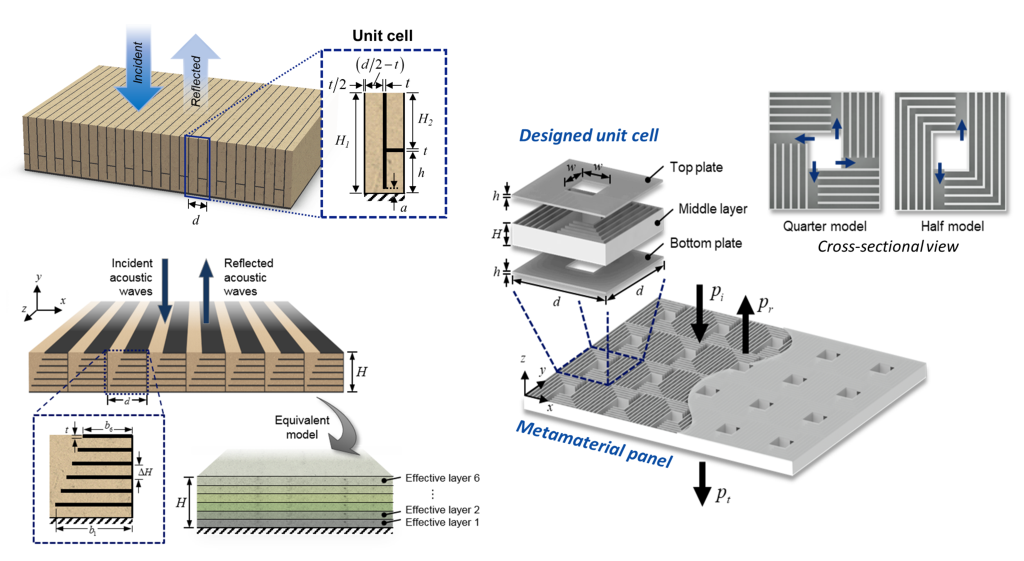
- Dr. Mohammad Mirzaali - Designer materials with tunable properties
Assistant Professor, Faculty of Mechanical, Maritime and Materials Egineering (3mE), Precision and Microsystems Engineering (PME), Delft University of Technology
Presentation
The presentation by Mohammad Mirzaali is available as a Pdf file.
 Creating new materials by learning from nature. That’s what Mohammad J. Mirzaali is working on. He looks specifically at hard and soft transitions, which connect a hard bone to a piece of soft tissue in our bodies, for example.
Creating new materials by learning from nature. That’s what Mohammad J. Mirzaali is working on. He looks specifically at hard and soft transitions, which connect a hard bone to a piece of soft tissue in our bodies, for example.
Source: TU Delft Stories
Nature inspires new materials

Auxetic Structures by Pi Lab (Fillip Studios),
in collaboration with Mohammad Mirzaali & Amir Zadpoor (TU Delft), Kees Storm & Wouter Ellenbroek (TU/e).
References
- Mirzaali, M. J., Ghorbani, A., Nakatani, K., Nouri-Goushki, M., Tümer, N., Callens, S. J. P., Janbaz, S., Accardo, A., Bico, J., Habibi, M., Zadpoor, A. A., Curvature Induced by Deflection in Thick Meta-Plates. Adv. Mater. 2021, 33, 2008082 https://doi.org/10.1002/adma.202008082
- Mirzaali, M.J., Pahlavani, H., Yarali, E. et al. Non-affinity in multi-material mechanical metamaterials. Sci Rep 10, 11488 (2020). https://doi.org/10.1038/s41598-020-67984-6
- M. J. Mirzaali, A. Caracciolo, H. Pahlavani, S. Janbaz, L. Vergani, and A. A. Zadpoor, "Multi-material 3D printed mechanical metamaterials: Rational design of elastic properties through spatial distribution of hard and soft phases", Appl. Phys. Lett. 113, 241903 (2018) https://doi.org/10.1063/1.5064864
- M. J. Mirzaali, H. Pahlavani, and A. A. Zadpoor, "Auxeticity and stiffness of random networks: Lessons for the rational design of 3D printed mechanical metamaterials", Appl. Phys. Lett. 115, 021901 (2019) https://doi.org/10.1063/1.5096590
Header picture by Ernst de Groot: Prototype metamaterial consisting of 50 non-linear locally resonant unit cells fabricated from an aluminum alloy sheet. (Priscilla Brandão Silva, Metamaterials with tunable dynamical properties (TU/e))




